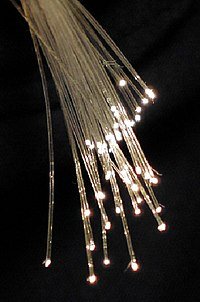One Group Optical Fiber Theoretically, the image created due to the use of advanced technologies such as DWDM is capable of delivering the total bandwidth of all the optical fibers currently being transmitted to the world (~ 100 terabytes per second per fiber [1])
Optical fiber is a type of thin, transparent fiber, typically made of glass or plastic, which is used for light transmission. Fiber Optics is a branch of applied science and engineering that discusses this optical fiber.
Large amounts of information can be transported in a very short time with optical fiber. Among the many advantages of optical fiber, the data transport is less in decaying, free from electromagnetic effects etc.
Optical fiber is widely used in telecommunications. Apart from this, the use of illumination, sensor and photo editing is also being used.
History
The optical concept as the medium of communication was first discovered in 1790 by the French scientist Claude Chappe Optical Telegraph. In this process, the human operator sent messages from one tower to another. But after the electrical telegraph came, this method became ineffective. Later, Alexander Graham Bell invented optical telephone system in 1880 which became known as a photofone. He thought of sending the light siganyal in the air but could not properly transmit the weather light. As a result, this purpose was hindered. In the current fiber that reflects the full internal reflection of light, Swiss physicist Daniel Collodon and French physicist Jacones Babinet discovered in 1840. With this idea, Henrik Lamm and Munich, a student in the 1920's, were able to send televised images or images through a transparent crescendo. But the quality of their discovered image was not very good. The way it was transmitted so far, all of them were uncladding. That is why most of the light was spreading around and the Siganyal was weak. Later, American physicist Brian O'Brien was the first to be able to use cladding optical fiber.
Comparison of electrical transport
Optical fiber or electrical (or copper) of which will be used in the communication system depends on some exemptions. In cases where the need for high bandwidth or sending information over a distance, generally optical fiber is preferred. Its main advantage is that the data loss is very low, so it can be used without amplifier or repeater at a higher distance. And its data-carrying power is so much that it will require thousands of electrical links to replace this capability, to replace only one optical fiber. Much lighter than fiber copper: The 700 km telescopic copper cable weighs 20 tons. The same is made only if fiber is made, then only 7 kg glass [1]. The more advantage is that crossfire passes along multiple fibers as well as crosses, which is a problem of any electric cable.
Electricity is used in short distances and in small bandwidth systems, because
Compensation Costs Low Splicing Costs of Communications and Receiver Costs Simplicity and power of sending signals simultaneously
Generally, optical fiber is not used in low-speed systems due to the electrical connection, but these technologies have been made in the laboratory.
In some cases optical fiber may also be used in a short distance or in low bandwidth, because
Electromagnetic interference, optical fiber in the prevention of molecular radioactivity, high electrical resistance, which can be used in high voltage electrical appliances. Wheel weights, especially not important sparks in airspace, can also be used with combustible materials, electron-magnetic Do not radiate, and do not damage the signal Tap the difficult, which security gurutbapurnatarera size is too small
Governmental value
Many manufacturers make optical fiber. Some of these values have been made for fiber to work properly in any system. The International Telecommunication Union has released several standards related to fiber. Notable among them
ITU-T G.651, "50/125 μm Multimedia Grade Index Optical Fiber Cable Act" ITU-T G.652, "Single Mode of Optical Fiber Cable"
Other values have been published from various organizations, which indicate various competencies in fiber. Some values are:
10 Gigabit Ethernet FDDI Fiber Channel Gigabit Ethernet HIPPISDHSONET